So, the cat picture brought drove of viewers to the previous post. I saw numbers I have not seen in months. Nearly five people visited for the cat alone. I say “nearly” because I think one was accidental, and aborted loading once they realized whose blog it was.
Still, I’m encouraged, and add the second cat . . .

How about them eyes! . . . looks positively ready to fly into the wild blue . . . and appropriately, his name is Jet.
But, on to the planes.
Note: I just found out that all the links in the Smithsonian catalog changed. That means that links referencing the museum’s database will return a dead link error (error 404). I’m not going back through the posts to update the links. One, because it’s a lot of work, and two, because no one mentioned it. If you’re looking for the Smithsonian’s entry for a plane, just search under the name.
On the last post I mentioned the Republic F-105D Thunderchief role as part of the Wild Weasels. This is what they were trying to foil.

Interesting and dangerous work. Heroic, one could say.
Anyway, there were a few other planes hanging up there whose photos I snapped. I briefly mentioned the Westland Lysander, and here are a few other photos of it.


It was named after a Spartan general, and because of it’s short-field abilities, it was used in WW II for clandestine operations behind enemy lines, making use of improvised landing strips to drop off or pick up agents.
The shape of the wings give it, at least to my eyes, a dragonfly-like look.
Another hanging plane near the main corridor is the Naval Aircraft Factory N3N.

Besides its wartime duties, and its duties in the Coast Guard, it was also used as the crop duster attacking Cary Grant in the movie North by Northwest. It’s also unique in that it was manufactured by the Navy, and not by private industry.
Also hanging way up there, is a Bowlus 1-S-2100 Senior Albatross.

I’ve always liked the idea of a glider. Like a few other methods relying solely on air currents, it seems to me as the purest way to fly, and likely one of the closest to approximating “flying” as a human-expressed desire.
A last look at the adornments of the Lope’s Hope, the Curtis P40E Warhawk . . .

. . . and we head into the early days of aviation history.


With deference to modern models, these seem to me more interesting. Perhaps because the planes themselves are more interesting. Don’t get me wrong; I can admire the capabilities of increasingly more modern aircrafts, and marvel at innovations making aircrafts both awesome in the traditional sense of the word, and awesome in its modern interpretation.
But, come on . . . imagine sitting in one of these . . .


That is, as the caption indicates a Baldwin Red Devil. The designer toured the country providing flying lessons for $500 . . . provided the students could show proof of having life insurance. He had more bookings than he could handle.

As usual, them so inclined can go to the SmugMug Gallery (HERE). There you can see photos in their original sizes. It’s also easier reading these signs.
For instance, the sign in this photo says “Curtis N-9H“.

The Curtis N series was a slightly more complicated plane then the Red Devil, as can be seen by the structure (the full size photo shows all the structural detail).
It had a central float, and outboard wings mounted smaller floats. The design was indeed more complicated, and this was the first American naval plane incorporating wind tunnel data (from MIT). Notice all that nice wood treatment . . . someone made that float by hand (my guess only; I don’t know for sure, but strongly suspect).
Handcrafted parts are also a part of modern planes, but they are more evident in these older stepping stones in aviation history.

The Verville-Sperry M-1 Messenger was built to replace motorcycle messengers.

Whenever possible I provide links to outside sources, but for some planes, like the 1912 Gage Biplane below, I can only link to the Smithsonian’s own listing. Why bother with my own photographs if someone can just go and browse the Smithsonian Artifact Collection?
Beats me . . . still, I persevere.
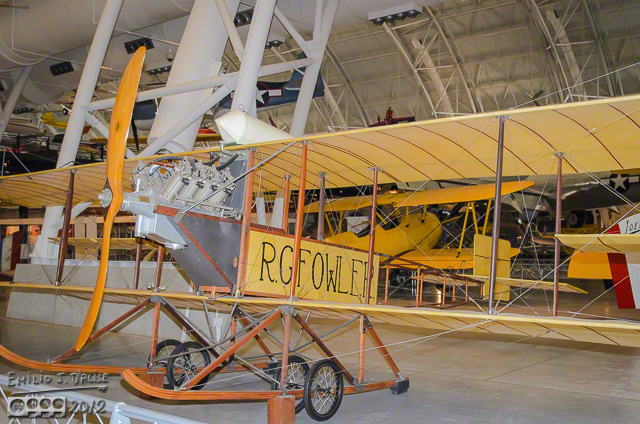

Named the Fowler-Gage Biplane in honor of its pilot, click on the link to read more about it.


Even in this portion of the museum, where there are lower ceilings, there are a few planes hanging above your head as you meander through the displays.

Despite the name, the Benoist Land Tractor Type XII is, in fact, an airplane. My best guess is that the “tractor” part differentiated it from the “pusher” type aircrafts. But what do I know? I make stuff up as I go along, and as most people are lazy, they just go with it without doing any checking on their own.
Interestingly, for them who don’t click on links, on 1 March 1912, Albert Berry used a headless Type XII to complete the first parachute jump from an airplane.
Also, On 6 November 1912 Tony Jannus flew a model XII mounted with floats 1,973 mi down the Missouri and Mississippi rivers from Omaha, Nebraska to New Orleans, arriving on 16 December.
Another interesting plane suspended from the ceiling is the Nieuport 28C.1, the first aircraft to see operational service with an American fighter squadron.

It’s a French-designed airplane, and it was not the Air Force first choice, but what was available.
What they really wanted was the SPAD XIII . . . (SPAD XVI pictured below).


Now, you will notice I don’t have a photo of the entire plane. Two reasons . . . oh, OK; only one reason . . .

See, that there is what I want on both our cars (my wife has no interest in it, but I occasionally drive the car she drives). I gots to tell you, within a month of so, the quality of drivers on Colorado’s highways would greatly improve. Alas, it’s only a dream.
By the way, SPADs were flown by Billy Mitchell, considered the father of the U.S. Air Force. People interested in the early history of the U.S. Air Force would do well to click on the link.
Actually, I was torn . . .

That’s also a beauty!
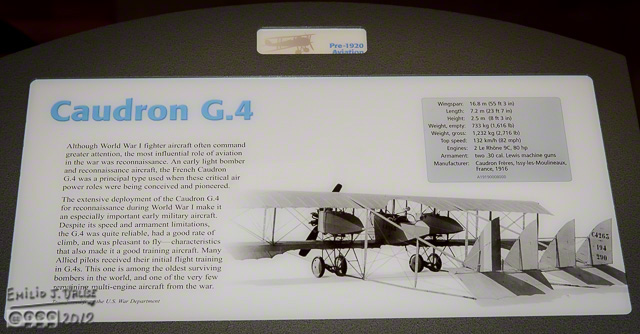
The Caudron G.4 was a bomber, and quite impressive for the time.


Did I mention the the appealing feature?

Oh, yeah . . . that’s what I’m talking about!
Of course, not everything was French made . . .
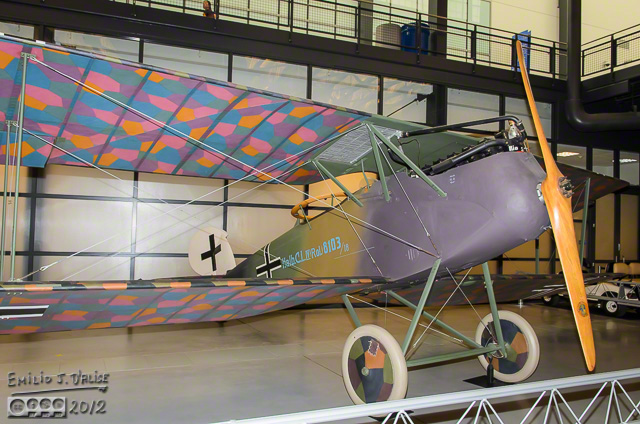
The color scheme alone inspired terror in the heart of all who faced this beast!
Here it is with a more ominous color scheme . . .
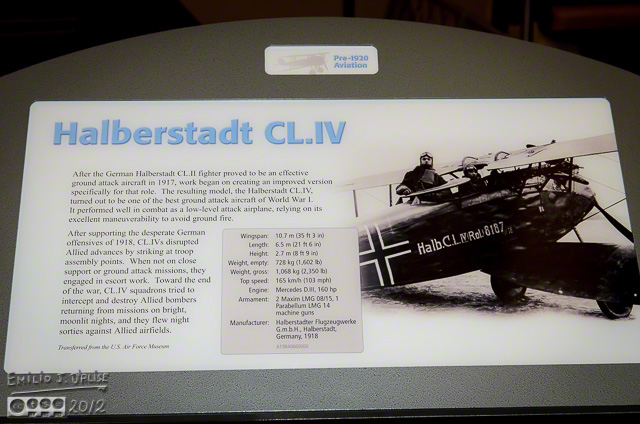
While I make light of the color scheme above, the Halberstadt CL.IV was an effective ground attack aircraft. I imagine those who were at the receiving end were more respectful of it than I’m being now.
The last aircraft from this area of the museum that I photographed is this precursor to the successful design of the Wright Flyer, the Langley Aerodrome A.
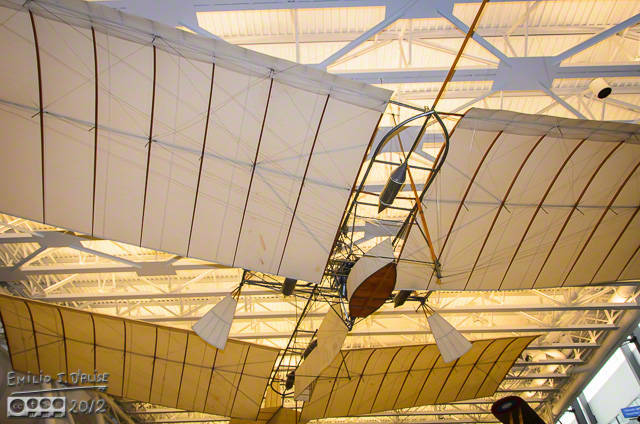
I say it was a precursor, but not really, as the Aerodrome (air runner) was not designed to handle flight loads, and had nothing in common with the development of the Wright Flyer.
However, it is interesting reading the history and feud between Orville Wright and The Smithsonian with respect to the Aerodrome.

The above photo shows the area covered by this write-up of my visit.
I’ll close this post by pointing out that aircrafts are not the only things presented at the museum. For instance, there are lots of period pieces, details, papers, historic accounts, etc.
For me, it’s still mostly a visual tour . . .



And, most of all, it is a testament to man’s dreams . . .


Well, OK . . . my dreams.
For them who are interested, I remind them the above photos are available in higher resolution at the SmugMug Gallery HERE.
The next post will deal with newer stuff. Thanks for visiting, and hope it was an informative foray into a small part of aviation history.
~ ~ ~ ~ ~ ~ o o o o o o ~ ~ ~ ~ ~ ~

Astute persons might have noticed these doodles, and correctly surmised they hold some significance for me, and perhaps for humanity at large.
If you click on the doodle, and nothing happens, this is the link it’s supposed to go to: https://disperser.wordpress.com/2011/12/26/palm-vx-and-i/.
<><><><><><><><><><o><><><><><><><><><o><><><><><><><><><>
Note: if you are not reading this blog post at Disperser.Wordpress.com, know that it has been copied without permission, and likely is being used by someone with nefarious intention, like attracting you to a malware-infested website. Could be they also torture small mammals.
<><><><><><><><><><o><><><><><><><><><o><><><><><><><><><>
Please, if you are considering bestowing me some recognition beyond commenting below, refrain from doing so. I will decline nominations whereby one blogger bestows an award onto another blogger, or group of bloggers. I appreciate the intent behind it, but I would much prefer a comment thanking me for turning you away from a life of crime, religion, or making you a better person in some other way. That would actually mean something to me.
Should you still nominate me, I will strongly suspect you pulled my name at random, and that you are not, in fact, a reader of my blog. If you wish to know more, please read below.
About awards: Blogger Awards About “likes”: Of “Likes”, Subscriptions, and Stuff
Note: to those who may click on “like”, or rate the post; if you do not personally hear from me, know that I am sincerely appreciative, and I thank you for noticing what I do.
. . . my FP ward . . . chieken shit.
THAT is an awesome cat photo! “Jet” suits purr-fectly . . . (couldn’t help that).
Those early planes took a lot of courage to fly (in my estimation). And it must be very interesting to look at the items in those display cases. Overall great photos!
LikeLike
Nice cat! 😉
LikeLike
Gorgeous eyes on the cat. 🙂 (Just following the theme here). Still like the warhawk planes the best.
LikeLike
I knew it!!
. . . chicks dig cats!
LikeLike
I like the older planes better too. But the Lope’s Hope is pretty cool.
LikeLike
What’s with the Warhawk getting so much love?
I mean, it’s OK, but it’s not the cat’s meow . . . or is it?
LikeLike
Great cat photo.
Planes like the Curtis Warhawk always appealed to me most, even more than more streamlined versions following later.
I wonder how many of your readers have actually flown a biplane? I was taught at a very early age in my Dad’s Hornet Moth.
LikeLike
The heck with the readers; I’ve not flown a biplane. I like the idea of the increased gliding potential, but would like a twin-motor for redundancy.
However, not likely I’ll ever fly one now . . . know a bit more about planes than I used to.
LikeLike
The other big advantage of a biplane was the short landing strip it needed. We used to land on golf clubs, beaches, sports fields, meadows …
LikeLike
I like the blue eyed cat. Airplanes are above my head…
LikeLike
What a coincidence! . . . they’re usually above my head as well, or at least that’s where I see them most often.
LikeLike
The cat nearly drove me away. If it weren’t for the title, I’d probably have left without enjoying all those gorgeous airplanes. That wooden propeller! What a beauty.
But I did also enjoy your cynical exploitation of moggie images. Glad to find there is a use for those sinuous, creepy felines after all. But can I bring myself to post a cat, even if it will increase hits on my blog? Probably not. I hate cats. (Ducks)
Perhaps I’m not a proper chick… 😉
LikeLike
Sinuousness is creepy? I’ll have to change how I move . . .
As for exploitation . . . not so much. My viewership is actually dropping.
LikeLike
It’s only creepy if you’re a cat 😉
LikeLike